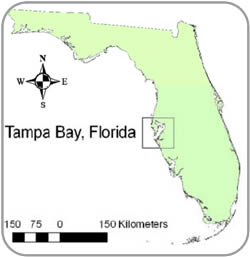Tampa Bay Research
Topics
Ecosystem Services Research In Communities Tampa Bay Study (2 pp, 277KB, About PDF)
Issue
The Ecological Research Program (ERP) in EPA's Office of Research and Development is studying the ways ecosystem services benefit human health and well-being in the Tampa Bay Estuary Watershed as part of a larger research effort to better understand the value of ecosystem services.
Tampa Bay is Florida's largest open-water estuary, supporting one of the world's most productive natural systems and is home to a large and growing urban center. With the success of much of the population's activities depending on the quality of the Tampa Bay ecosystem, it is vital that planners incorporate accurate values of ecosystem services into future scenario projections for the area.

Figure 1 Tampa Bay, Florida
Humans receive many benefits from ecosystems. Wetlands protect us from floods; rivers and lakes provide water and fish; bees pollinate our crops; and forests and beaches provide recreation and relaxation. These and many other ecosystem services ensure human health and well-being, yet they are often taken for granted, thinking they are free and infinitely available.
There has been growing recognition that the contributions of nature's services have not been fully considered by policy makers and planners, largely because of a lack of scientific and socioeconomic knowledge about these services. The full range of benefits derived from ecosystem services needs to be considered if we are to continue to benefit from them. Until then, we cannot know the true costs or benefits of our environmental decisions.
Science Objective
ERP scientists are partnering with local governments, planning organizations, and citizen and business groups to identify and assess the ecosystem services in Tampa Bay. They will focus on how current and proposed population growth and development may impact ecosystem services.
Because the study of ecosystems falls into many different scientific disciplines, ranging from the microscopic scale to landscape ecology and atmospheric sciences, experts from many fields will participate in this study.
The research objectives of the Tampa Bay study are to:
Delineate and quantify ecosystem services provided by the Tampa Bay ecosystem
Assess the likely changes in environmental stressors and land use patterns through 2050
Model the relationships among stressors, ecosystem structure and functioning, and ecosystem services
Place values on Tampa Bay's ecosystem services in terms of human well-being
Model multiple future scenarios of different land-use changes and projected impacts on ecosystem services and human well-being
Develop a Web-based tool to characterize effects of land use changes on ecosystem services and human well-being
Scientists will estimate ways that the landscape will change from 2005 through 2050 as a result of projected development and land-use proposals and how ecosystem services would respond to these development stressors.
Working with ecological economists, they will assign monetary and non-monetary values and measures of human well-being to the ecosystem services provided by the Tampa Bay ecosystem.
The team will develop multiple maps of possible future land use, based on projected development and land-use changes. They also will produce a quantitative assessment of ecosystem services under various management plans.
Scientists plan to produce an atlas of the region that links management plans to the locations of changes in ecosystem services. They also will develop an interactive simulation model of the ways land use change affects ecosystem services.
Application and Impact
Researchers will provide resource managers, planners, government decision makers and others with the tools and information they need to best manage growth and development while maintaining valuable ecosystem services.
Ultimately, the science will enable regions, states, and local communities to make informed decisions to support sustainable planning for current and future generations.
References
Environmental Protection Agency, Ecological Benefits Assessment Strategic Plan, EPA 240/R-06/001, 2006.
Millennium Ecosystem Assessment. 2005. Ecosystems and Well-Being: Wetlands and Water synthesis. World Resources Institute, Washington DC.
Contact
Marc Russell, Ph.D., EPA's Office of Research and Development, (russell.marc@epa.gov) 850-934-9344
![[logo] US EPA](https://webarchive.library.unt.edu/eot2008/20081010192237im_/http://www.epa.gov/epafiles/images/logo_epaseal.gif)